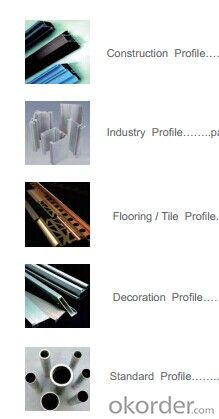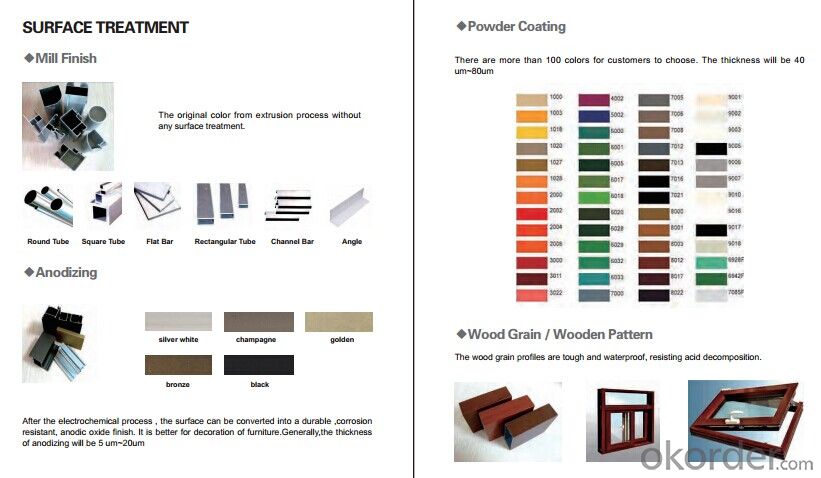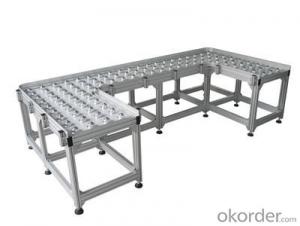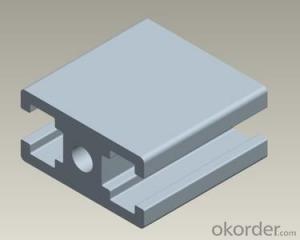Decoration aluminium extrusion profiles
- Loading Port:
- China Main Port
- Payment Terms:
- TT OR LC
- Min Order Qty:
- -
- Supply Capability:
- -
OKorder Service Pledge
OKorder Financial Service
You Might Also Like
Aluminium is a relatively soft,durable, lightweight, ductile and malleablemetal with appearance ranging from silvery to dull gray,depending on the surface roughness. It is nonmagnetic and does not easilyignite. A fresh film of aluminium serves as a good reflector (approximately92%) of visible light and an excellent reflector (as much as98%) of medium and far infrared radiation. The yield strength of pure aluminium is 7–11 MPa,while aluminium alloys have yield strengths ranging from200 MPa to 600 MPa. Aluminium has about one-third the density and stiffnessof steel. It iseasily machined,cast, drawn and extruded.
Alu Profile:
Material | Alloy 6063,6061,6005or according to customer’s choice |
Temper | T3, T4, T5, T6 |
Surface | Anodize, electrophoresis, powder coating, PVDF coating, wood grain painting, matted, etc. |
Length | Coating 6.5 meters, Anodizing 6.5 meters, Mill finish 5 meters |
Application | Industrial, electrical equipment(TV set, air conditioner, refrigerator, computer), decoration,construction, transportation |
Custom Made | We can package following with customer's request. |



FAQ:
1. What is the form of payment?
Normally 30% TT, L/C at sight
2. Type of quotation?
FOB, CFR, CIF
3. Port of loading?
Guangzhou/Shenzhen port
4. Delivery time?
15-20 days after client’s deposit
- Q:How strong are aluminum profiles?
- Aluminum profiles are known for their exceptional strength-to-weight ratio, making them quite strong despite their lightweight nature. They can withstand various loads and stresses, making them suitable for a wide range of applications, including construction, aerospace, automotive, and industrial sectors. Additionally, aluminum profiles can be reinforced or combined with other materials to further enhance their strength and durability.
- Q:Which price is expensive for aluminum profiles 6063-T6 and 6063-T5?
- 2.2, second digits: an alloy that indicates the addition of alloying elements or impurities in the original alloy.0: watch master alloy1: table primary alloy is modified by the first timeThe original alloy of table 2: has been modified second times2.3, third, and four digits:Pure aluminum: represents the original alloyAlloy: the designation of individual alloys"- >: the later Hn or Tn indicates the condition of the work hardening or the symbol of the heat treatment state-Hn: indicating the symbol of temper of non heat treated alloys-Tn: the symbol of temper of heat treated alloysT5It is cooled by a high temperature molding process and then artificially aged. The utility model is suitable for the artificial aging product after being cooled by the high temperature forming process without being cold processed (which can be straightened and straightened without affecting the mechanical performance limit).
- Q:How do you clean and maintain aluminum profiles?
- To clean and maintain aluminum profiles, you can follow these simple steps: 1. Start by removing any loose dirt or debris from the surface of the aluminum profiles using a soft brush or cloth. 2. Prepare a cleaning solution by mixing mild dish soap or a non-abrasive cleaner with warm water. Avoid using harsh chemicals or abrasive cleaners as they can damage the aluminum finish. 3. Dip a soft cloth or sponge into the cleaning solution and gently scrub the aluminum profiles. Be sure to clean all the corners and crevices thoroughly. 4. Rinse the profiles with clean water to remove any soap residue. You can use a hose or a bucket of water for this step. 5. Dry the aluminum profiles completely using a soft, lint-free cloth. This will prevent water spots or streaks from forming. 6. For regular maintenance, you can use a specialized aluminum cleaner or polish to restore the shine and protect the surface. Follow the instructions on the product for best results. 7. It is important to avoid using abrasive scrubbers, steel wool, or harsh chemicals as they can scratch or damage the aluminum finish. Also, never use acidic cleaners or vinegar on aluminum as they can cause corrosion. 8. If you notice any scratches or minor damages on the aluminum profiles, you can use a touch-up paint specifically designed for aluminum to repair them. Follow the manufacturer's instructions for application. Remember, regular cleaning and maintenance will help preserve the appearance and longevity of your aluminum profiles.
- Q:How do aluminum profiles perform in vibration isolation applications?
- Due to their unique properties and characteristics, aluminum profiles prove to be highly effective in applications involving vibration isolation. The utilization of aluminum profiles in such scenarios aids in the reduction and mitigation of vibrations, thereby establishing a stable and isolated setting. The high strength-to-weight ratio of aluminum profiles stands as one of the primary factors contributing to their efficacy in vibration isolation. Aluminum, being a lightweight material, enables the construction of structures capable of efficiently absorbing and dissipating vibrations. This lightweight nature ensures that the profiles do not add excessive weight to the system, as doing so could amplify vibrations instead of dampening them. Furthermore, aluminum profiles exhibit exceptional damping capabilities. Damping refers to a material's ability to absorb and dissipate energy from vibrations. Aluminum inherently possesses damping properties, which play a significant role in diminishing vibration levels. As a result, the profiles effectively isolate vibrations and prevent their transmission to other components or structures. In addition, aluminum profiles can be easily customized and designed to meet specific requirements regarding vibration isolation. Engineers can tailor the profiles' geometries and configurations to effectively attenuate vibrations. This design flexibility permits the optimization of profiles for diverse applications and environments, ensuring maximum effectiveness in vibration isolation. Moreover, aluminum profiles offer commendable corrosion resistance, a crucial factor in vibration isolation applications exposed to harsh operating conditions. This resistance to corrosion guarantees the durability and reliability of the profiles, maintaining their performance over extended periods. In conclusion, due to their lightweight nature, excellent damping capabilities, customization options, and corrosion resistance, aluminum profiles prove to be highly suitable for vibration isolation applications. Through their efficient absorption and dissipation of vibrations, aluminum profiles enable the creation of stable and isolated environments, effectively minimizing the impact of vibrations on surrounding components or structures.
- Q:Can aluminum profiles be an alternative to steel in certain applications?
- Yes, aluminum profiles can be a viable alternative to steel in certain applications. Aluminum offers numerous advantages such as being lightweight, corrosion-resistant, and easily recyclable. It is commonly used in industries like aerospace, automotive, construction, and electronics. However, steel may still be preferred in applications requiring high strength or extreme temperatures. Ultimately, the choice between aluminum and steel profiles depends on specific requirements and considerations.
- Q:Can aluminum profiles be used in signage or display applications?
- Yes, aluminum profiles can be used in signage or display applications. Aluminum profiles are lightweight, durable, and versatile, making them suitable for various applications such as sign frames, display stands, and exhibition booths. Additionally, aluminum profiles can be easily customized and offer a sleek and modern appearance, making them a popular choice in the signage and display industry.
- Q:How do aluminum profiles perform in vibration and shock absorption applications?
- Aluminum profiles are known to excel in vibration and shock absorption applications due to their lightweight yet durable nature. They have excellent strength-to-weight ratio, allowing them to effectively dampen vibrations and absorb shocks. Additionally, aluminum profiles possess good flexibility and resilience, enabling them to withstand repeated impacts without deformation or failure. Their high thermal conductivity also aids in dissipating heat generated during vibrations. Overall, aluminum profiles are highly suitable for vibration and shock absorption applications, providing reliable performance and longevity.
- Q:Are aluminum profiles suitable for decorative applications?
- Indeed, decorative applications can benefit greatly from the use of aluminum profiles. This material, known for its versatility, provides numerous advantages in decorative contexts. To start with, aluminum profiles can be easily shaped and molded into various designs, offering endless possibilities for decorative applications. Designers have the freedom to extrude them into different shapes, sizes, and patterns, allowing for the creation of unique and visually pleasing decorative elements. Furthermore, aluminum profiles exhibit excellent durability and resistance to corrosion, making them suitable for both indoor and outdoor decorative applications. Thanks to their rust and weather resistance, decorative elements made from aluminum profiles can maintain their appearance for an extended period. Moreover, aluminum profiles can be finished in different ways to enhance their decorative appeal. Anodizing or powder-coating can be applied to the surface, adding color, texture, and protection. These finishing options allow for customization and the ability to harmonize the profiles with the overall design scheme. Additionally, aluminum profiles possess the advantageous combination of being lightweight and strong, facilitating their installation and handling during the decorative application process. This characteristic is especially valuable in situations where weight is a consideration, such as with suspended or wall-mounted decorative elements. Finally, it is worth noting that aluminum is an environmentally friendly and sustainable material. It is entirely recyclable, and the production process of aluminum profiles requires significantly less energy compared to other materials. By choosing aluminum profiles for decorative applications, one aligns with sustainable design principles and contributes to reducing the environmental impact. In conclusion, the versatility, durability, corrosion resistance, customization options, lightweight nature, and sustainability of aluminum profiles make them highly suitable for decorative applications. Whether it is for interior or exterior decorative elements, aluminum profiles offer a wide range of possibilities to enhance the aesthetic appeal of any space.
- Q:What are the different types of surface protection for aluminum profiles?
- There are several types of surface protection for aluminum profiles, including anodizing, powder coating, painting, and laminating. Anodizing involves creating a durable oxide layer on the surface of the aluminum, providing corrosion and wear resistance. Powder coating involves applying a dry powder to the surface and then curing it with heat, creating a tough and decorative finish. Painting involves applying liquid paint to the surface, providing both protection and aesthetic appeal. Laminating involves applying a layer of protective film or sheet to the surface, offering scratch resistance and added durability.
- Q:The number of aluminum profiles can be meters or KG. How exactly is it? How do you understand that?
- According to the calculated root.The general material company is used to calculate the weight or root. Few meters.
1. Manufacturer Overview |
|
|---|---|
| Location | |
| Year Established | |
| Annual Output Value | |
| Main Markets | |
| Company Certifications | |
2. Manufacturer Certificates |
|
|---|---|
| a) Certification Name | |
| Range | |
| Reference | |
| Validity Period | |
3. Manufacturer Capability |
|
|---|---|
| a)Trade Capacity | |
| Nearest Port | |
| Export Percentage | |
| No.of Employees in Trade Department | |
| Language Spoken: | |
| b)Factory Information | |
| Factory Size: | |
| No. of Production Lines | |
| Contract Manufacturing | |
| Product Price Range | |
Send your message to us
Decoration aluminium extrusion profiles
- Loading Port:
- China Main Port
- Payment Terms:
- TT OR LC
- Min Order Qty:
- -
- Supply Capability:
- -
OKorder Service Pledge
OKorder Financial Service
Similar products
New products
Hot products
Hot Searches
Related keywords
































